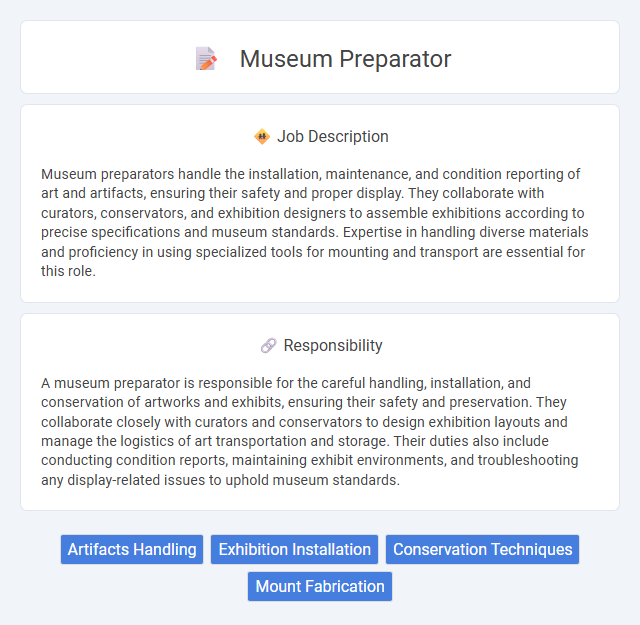
Museum preparators handle the installation, maintenance, and condition reporting of art and artifacts, ensuring their safety and proper display. They collaborate with curators, conservators, and exhibition designers to assemble exhibitions according to precise specifications and museum standards. Expertise in handling diverse materials and proficiency in using specialized tools for mounting and transport are essential for this role.
Individuals with a strong attention to detail and patience are likely suited for a museum preparator role, as the job involves handling delicate artifacts and ensuring accurate displays. Those who are comfortable with manual dexterity tasks and can work meticulously under sometimes restrictive conditions might find this position fitting. People who prefer dynamic or highly social environments may find the solitary and precise nature of the work less suitable.
Qualification
A museum preparator requires a detailed understanding of art handling, conservation techniques, and exhibit installation. Proficiency in using specialized tools and equipment for mounting, framing, and lighting artifacts ensures the preservation and display quality. Formal qualifications often include a degree or certification in museum studies, art history, or conservation, combined with hands-on experience in curatorial support and collection management.
Responsibility
A museum preparator is responsible for the careful handling, installation, and conservation of artworks and exhibits, ensuring their safety and preservation. They collaborate closely with curators and conservators to design exhibition layouts and manage the logistics of art transportation and storage. Their duties also include conducting condition reports, maintaining exhibit environments, and troubleshooting any display-related issues to uphold museum standards.
Benefit
Working as a museum preparator likely offers benefits such as hands-on experience with rare artifacts and artwork, enhancing expertise in preservation and exhibition techniques. The role probably provides opportunities for collaboration with curators and conservators, fostering professional growth in the cultural heritage sector. Employees may enjoy a stable work environment with access to unique educational resources and networking within the museum community.
Challenge
Museum preparator roles likely involve the challenge of carefully handling and preserving delicate artifacts while balancing the need for efficient exhibit setup. The probability of facing complex problem-solving situations increases when adapting to varying display requirements and environmental conditions. Mastery in attention to detail and technical skills is often essential to overcome these challenges successfully.
Career Advancement
Museum preparators develop expertise in artifact handling, exhibit installation, and conservation techniques critical for advancing to roles such as collections manager or curator. Mastery of preservation methods, inventory control, and exhibit design enhances opportunities for promotions within museum departments. Continuous professional development and networking within the museum community significantly contribute to career growth and leadership positions.
Key Terms
Artifacts Handling
Museum preparators specializing in artifacts handling are responsible for the safe packing, moving, and installation of valuable historical objects. They use conservation-grade materials and techniques to prevent damage during transportation and display. Their expertise ensures the preservation and integrity of artifacts throughout exhibitions and storage.
Exhibition Installation
Museum preparators specializing in exhibition installation handle the precise assembly and arrangement of artworks and artifacts to ensure visual impact and preservation. They collaborate closely with curators and conservators to interpret installation plans, using specialized tools and techniques to mount, secure, and protect exhibits. Expertise in handling delicate objects and understanding environmental controls is crucial for maintaining the integrity of displays throughout the exhibition duration.
Conservation Techniques
Museum preparators specialize in the application of advanced conservation techniques to preserve and protect artifacts during installation and display. They utilize environmental controls, such as humidity and light regulation, alongside specialized materials to prevent deterioration and physical damage. Expertise in handling delicate objects through cleaning, repair, and stabilization ensures the longevity and integrity of museum collections.
Mount Fabrication
A museum preparator specializing in mount fabrication designs and constructs custom mounts that securely display artifacts while preserving their condition. Expertise in materials such as acid-free foam, archival fabrics, and inert metals ensures mounts support the object's integrity and enhance visitor experience. Precision in fabricating mounts tailored to various artifact shapes and weights is essential for optimal exhibition safety and aesthetics.
 kuljobs.com
kuljobs.com